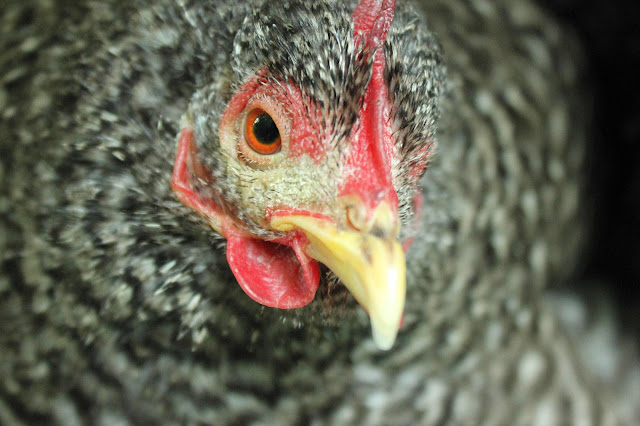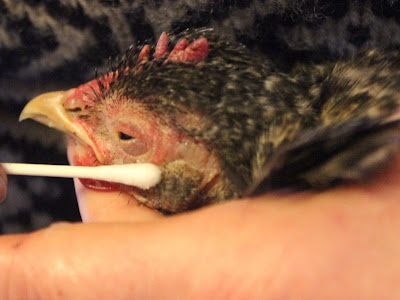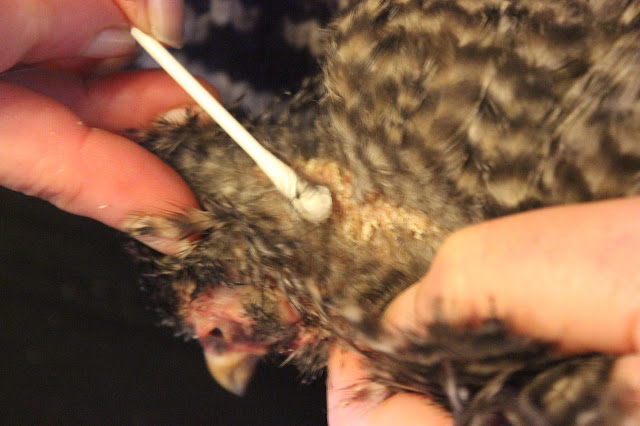In the following article I set out the information I used and protocols I created from reading
through the available research on red mite, coupled with that garnered from my own
observations and experience. The most important features of all parasitism, in my experience, is to clearly identify the parasite, understand its life-cycle and combine this with an assessment of the particular level of infestation. Only then can we fully comprehend what our actions should be and moreover without this knowledge we can waste vital time and energy on unnecessary treatments, instead of dealing with what can become a very real threat to our poultry.
 Red mite - Dermanyssus gallinae is a member of the arachnid family, thus a relation of the scaly leg mite, Knemidocoptes mutans, which I have written about here. However, the red mite belongs to the order Mesostigmata, many of which are non-parasitic mites but free-living and most importantly, predatory. Interestingly though with red mite, its life cycle necessitates obligatory parasitic attributes, such as its need to blood-feed upon a host in order to complete the three final subsequent phases in its development. These are specifically the eight-legged stages which take it from protonymph, through deutonymph to full adulthood. As witness my photo above, red mite, should be easier to treat because unlike the scaly leg mite, it is visible to the naked eye, particularly and most gruesomely when its has fed and become bloated and red in colour.
Red mite - Dermanyssus gallinae is a member of the arachnid family, thus a relation of the scaly leg mite, Knemidocoptes mutans, which I have written about here. However, the red mite belongs to the order Mesostigmata, many of which are non-parasitic mites but free-living and most importantly, predatory. Interestingly though with red mite, its life cycle necessitates obligatory parasitic attributes, such as its need to blood-feed upon a host in order to complete the three final subsequent phases in its development. These are specifically the eight-legged stages which take it from protonymph, through deutonymph to full adulthood. As witness my photo above, red mite, should be easier to treat because unlike the scaly leg mite, it is visible to the naked eye, particularly and most gruesomely when its has fed and become bloated and red in colour.
 Red mite - Dermanyssus gallinae is a member of the arachnid family, thus a relation of the scaly leg mite, Knemidocoptes mutans, which I have written about here. However, the red mite belongs to the order Mesostigmata, many of which are non-parasitic mites but free-living and most importantly, predatory. Interestingly though with red mite, its life cycle necessitates obligatory parasitic attributes, such as its need to blood-feed upon a host in order to complete the three final subsequent phases in its development. These are specifically the eight-legged stages which take it from protonymph, through deutonymph to full adulthood. As witness my photo above, red mite, should be easier to treat because unlike the scaly leg mite, it is visible to the naked eye, particularly and most gruesomely when its has fed and become bloated and red in colour.
Red mite - Dermanyssus gallinae is a member of the arachnid family, thus a relation of the scaly leg mite, Knemidocoptes mutans, which I have written about here. However, the red mite belongs to the order Mesostigmata, many of which are non-parasitic mites but free-living and most importantly, predatory. Interestingly though with red mite, its life cycle necessitates obligatory parasitic attributes, such as its need to blood-feed upon a host in order to complete the three final subsequent phases in its development. These are specifically the eight-legged stages which take it from protonymph, through deutonymph to full adulthood. As witness my photo above, red mite, should be easier to treat because unlike the scaly leg mite, it is visible to the naked eye, particularly and most gruesomely when its has fed and become bloated and red in colour.How do I know if I have a serious level of Red Mite?
- One of the first indications of a red mite infestations is that your poultry may stop roosting in the house and if they are free range, will prefer roosting in the trees!
- Birds stamping their feet in the coop, as they feel the mites crawling up their legs.
- Birds may show signs of irritation with each other, with lack of sleep causing them to be fractious and under stress. Just as in humans this can create conflict and irritation with neighbours.
- You may see blood spots (crushed mites) or even live ones crawling on the eggs in the nest boxes.
- Hens will go off lay. They may also seem fatigued, not as lively as usual and they may even look pale. This is obviously due to blood loss.
- There is a smell with red mite, apparently not everyone can sense it, to me it smells like vinegar and once your nose can identify it, it is a fail-safe proof you have red mite.
- You will feel mites dropping down onto your head and/or crawling onto you when you are in the coop or crawling up your hands when you collect eggs or take out the perches to clean the house!
An Aside: The Strange Parallel Between Host and Parasite
Below clutches of mites' eggs seemingly freshly-laid on the wood planking underneath the wire netting framed cover which had just been removed from one of our roosts. I can see five or maybe six eggs in the nest on the lower right. Top left I can make out a whole pile of eggs, I am guessing, in a communal nest and with the mites fussing around them. Do they guard them? Are they going to carry them away into some dark corner now they have been exposed to the light? I'm presuming they don't sit on them!
Red Mites - The Acid Test(s)
Here are a few quick tests to see if you have a bad infestation of mite.For the Squeamish: The Movement Test
Take a power or cordless drill switch it on and run it with the body of the drill lying flat against the walls, door or floor of the coop/hen house. The mites will be triggered by the vibration, thinking the hens are coming back into the coop. You will see exactly where they are hiding.For the Brave: The Heat Test
Place your hand on the wall, door and/or floor of the coop, leave it there for a few seconds. The mites nearest to your hand will start to emerge. They will also signal to those near at hand (sorry) so be very afraid!..or The Not So Brave
Place a heated stone, not a hot water bottle because they will infest that, in the coop and wait.For the Brave: The Hanky Test
Take a white paper handkerchief and run it all the way along the underside of the perch/roost after the birds have left the coop in the morning. If you have an infestation, it will be covered with tell-tale red streaks of squashed mites.Look No Hanky!
Here I'm making a preliminary test by running my hand under the roost/perch some three days after the first treatment, just to see if any one has hatched out in the meantime!Understanding the Red Mite's Life Cycle and Habits
As with all the parasites I have come across, understanding what they are about, is key to controlling the particular problem of their overgrowth. I write this rather than 'eradication' because, firstly there is not enough information on any of these creatures to understand if they have a symbiotic relationship with the host and secondly because red mite at low levels of population are caught and eaten by my chickens. It is human nature and certainly a commercially encouraged one, to think that everything needs to be 'zapped' to annihilation but recent research teaches us that some parasites, I'm thinking of beans and black fly, for example, are crucial to the development of the host. Who is to say if a low level of red mite in a coop doesn't regulate iron levels within birds, as this element is incredibly difficult to remove, except by blood letting, when it is in excess to requirement?
The illustration above, from Publicdomainpictures.com shows the female mite at the Deutonymph stage of development.
Below a video I made of a red mite infestation on an old cardboard box that had had three broodies in it - as you can see these have not fed, as luckily I became aware of them!
The illustration above, from Publicdomainpictures.com shows the female mite at the Deutonymph stage of development.
Below a video I made of a red mite infestation on an old cardboard box that had had three broodies in it - as you can see these have not fed, as luckily I became aware of them!
Important considerations, which help with control
- Unlike the scaly leg mite, Dermanyssus gallinae, is not host specific and does in fact spend most of its time off the host, usually only visiting the bird for a few hours at night, to feed upon its blood.
- Several studies have supported generalism in host choice for Red mites. It was previously thought they were avian specific but Dermanyssus gallinae have also been found on rodents and other mammals.
- Like the literary blood-sucker, the vampire, Dermanyssus gallinae shuns sunlight, spending most of its life hiding in the darkest areas of the chicken coop, hen house or barn.
- A distinctive feature and upon which I have never found any accord, is its ability to remain without food for an exceedingly long time, think months and even years!
- At all stages of its life, including, it has been recently postulated, the larval, it may feed upon blood but it is believed that a blood-meal is crucial in the three final stages, mentioned above. Furthermore, it is the females who need blood to develop and also during periods of reproduction, although the males are thought to take an occasional blood-feed.
- The life cycle of the red mite from egg to adulthood usually takes around 14 days but the time can be halved, if weather conditions are favourable.
- With reference to the above, mites prefer warm humid conditions to thrive and survive. At an optimum of 25°C to 35°C (77°F - 95°F) and 60% to 70 % humidity the mite population will 'explode' and quickly become an infestation.
- The red mite will go dormant when temperatures drop below 10°C (50°F) but temperatures above 45°C (113°F) are thought to be fatal.
- Red mites find their host through movement, heat (body temperature), CO₂ (respiration) and chemical signals (odours).
- If you have broodies in a coop, they will be a magnet for red mite, if you have an infestation.
- If you have chicks in a coop then red mite, if they are in sufficient numbers can cause severe problems for them and which can lead to fatalities.
- The females lay 4 to 8 eggs per day with an average in their life span of a total (depending on what paper you read) of 30 to 300 eggs.
- Mites are adept at finding places to hide, woodworm holes, screw threads and underneath dried poo(p) are just some of the crafty ideas they have for hide-and-seek.
Conclusions
From the above we can draw the following important inferences:
Firstly, that if mites are at infestation level, any chicks and/or juveniles should be removed immediately as they are the most at risk.
Just as an aside here, unless this is an emergency as with the above, no bird should be removed at night, as if you are unlucky you may hit the brief two hour period when the mites may be 'in residence'. However, as you carry the bird, you will soon know, as they will start to transfer to you but it is still a risk you don't need to take.
Treating the bird is totally unnecessary and moreover a waste of valuable time. Treatment needs to be swift and efficient, the life cycle of the red mite from egg to adult being very short, once it has created a large population within the coop, the exponential growth is alarming!
Broodies too should be removed from the coop and their nest boxes changed and their old ones and the straw preferably burned if you have a stove. Normally I would compost old straw but the mites can live in the compost bin and attach themselves to a bird at an opportune moment.
If you buy or inherit a second-hand coop or buy a broody hen then it is a good idea to check the house for mites with the tests above, even if the house has been unoccupied for many months. Check the broody for evidence of mite activity too. If you have bought her during the day, then chances are there should be nothing on her but she may have tell-tale skin irritation and damage which will testify to mites. If you have been given her in a box or with straw, then the possibility is that there are mites in her bedding. (I once carried a broody over from a neighbour's house and carried over some mites too).
Once you have established there are mites and you have treated them, you should recheck and retreat, if necessary in line with the life cycle, spacing out your checking and treatments accordingly. It is very important to remember that the weather will have an impact on when and how long the creatures take to hatch out and develop through their different stages.
If you live in a climate where the weather and humidity are optimum for mites, then you should do a routine check for them throughout the year.
Mites like to hide and they are good at it, so keeping the house clean, in particular, scraping the roosts and floor, so that there is less debris for them to hide in is very important. I also like to get the roost outside and tipped upside down, so that my birds can spy out and eat any of the mites that are hiding under them. Even mites that haven't fed and are at the 'grey ghost' stage are easily spotted as a tasty appetiser.
In the next article (Link Below) I will share the three ways I use to successfully get rid of red mite.
Until next time, all the very best from Normandie! Sue
© 2020 Sue Cross
In the next article (Link Below) I will share the three ways I use to successfully get rid of red mite.
Thanks for dropping by and do feel free to share experiences or ask for further information in the comment section. If you have enjoyed this piece and found it
useful think about sharing it with your family and friends, on social media and also maybe about joining this blog
and/or subscribing to my Youtube channel or even supporting us on
Patreon or
It all helps to keep me going!Until next time, all the very best from Normandie! Sue
© 2020 Sue Cross
RELATED ARTICLES
Red Mite Part 2 Prevention & 3 Cures: Essential Oil, Fire, Steam
Because I have access to all three Fire, Steam and Essential Oils, I
like to use a combination of all three but any one of them used alone ...read more
Common Poultry Lice identification, life cycle and major infestation periods
Menacanthus stramineusare ectoparasites, thus living on the skin...with a
short life span, which in adult form, is from 2 to 3 weeks read more
Common Poultry Lice - Treatment and Prevention
When you apply any sort of viscous carrier oil to a louse, the
spiracles, pores through which it breathes, become blocked, however, read more
Ticks - Identification, life cycle and lifestyle
I have to say right from the start the more I read about ticks the more
confused I get. There is a volume of information floating about...read more
Ticks - Treatment and Removal from a pigeon's face
The idea of using Tea Tree Essential oil is because it has anaesthetic,
antibacterial, antiviral, antiseptic, antimicrobial properties...read more
Scaly Leg and Face Mite Infestations Why They Happen & What To Do Part 1
I look at the correlation between specific
deficiency and parasitisation because it is fundamental to everything I
believe is wrong...read more
 Scaly Leg Mite Infestations What To Do Part 2
Scaly Leg Mite Infestations What To Do Part 2
I look at the options both medicinal and nutritional for dealing with this microscopic mite ...read more
Scaly Face Mite Infestations Treatment Part 3
If you haven't this miraculous substance already in your pantry then I
advise you to get some, both for your own and your poultry's health...read more

























